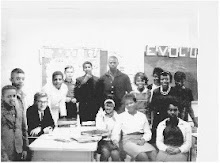Translation Questions - A Transcendent & Under-Utilized Probative
A translation question typically requires that a student be able to re-represent something presented in one symbolic form in another, or alternate form. This might be a charge to re-state in one’s own words what another student has said, or something written found in text. Translation involves taking one’s ideas, which themselves may be incomplete, and beginning the public process of converting them to a clear communicable form. It could be a charge to convert a picture into descriptive words, or the inverse. Translation of inchoate notions into apprehendible words is one of the most challenging aspects of effective writing. At a “clinical” level, a translation question is a form of diagnostic-teaching and instructional conversation that seamlessly causes a rotation of those who are speaking to the many others who tend to lapse into passivity. Judging by its inherent value it could be easier to grasp, than apparently it is to execute.
There are several studies that have incidentally provided some insight into the typical level of usage by teachers of translation questions. Guszak (1967) found teachers using them less than 9% of the time in a conventional classroom setting. Manzo (1969) found a dramatic difference in utilization in a remedial/clinical setting where those using the Directed Reading Activity (Betts, 1957) – about 1% translation questions, or the ReQuest Procedure- about 9% translation questions (Manzo, 1969a). So, it seems that the teaching approach being used makes a difference in inclination to utilize this question type. One of the goals of the present re-awaking process is to detail more and better ways to promote the fruitful raising of translation questions, by teachers, and ideally, by students of the teacher and of one another.
Adding the Translation Ingredient
There are any number of ways to foster translation questioning. For example, the tutor might say, “Can you tell me in your own words what this phrase, or these words, mean in this sentence ?” (Pointing to, or even reading aloud, the words “Ellen left one of her lives behind…”). Or, “What do you suppose that picture says/illustrates?” Or, if ReQuest is being conducted in a group situation, the classroom teacher might say: “Who can say Trish’s remark to ‘lives behind’ in another way?”
A second way to build the translation question gambit into oral language interactions is to make a personal commitment to ask essentially the same question as previously stated – (“say what someone else has said in other words”)- at least twice in every period of classroom discussion and comprehension checking. This should have the effect of creating a comfortable repetition of a key point or bit of information without taking on the character of drill, and while encouraging greater attention to the discussion; if students begin to anticipate that they might be asked to translate, they are more likely to shift into a more active and possibly interactive mode. Students tend, as do we all when listening, to function in a quasi-passive mode, expecting the speaker to repeat, underscore and even tell us when something is sufficiently important that we should write it down.
Establishing even a leitmotif of translation questions as part of one’s repertoire also provides a rather seamless way to support students with enrich limited language proficiency, as well as those with other language related and/or attention deficit problems. Importantly, this same essential pattern of questioning can be conducted at a pre-reading stage with pictures, where children are asked to simply tell what they see –translate the picture into words – and, along the way to have them re-translate what was said by a prior student as a means of having them listen carefully and learn acceptable (peer) language and poise from one another.
Another natural way to encourage self and students to engage the translation question more fully is to analyze proverbs and idioms, which naturally tend to say one thing at a simple, or literal level and another at a more abstract level (Manzo, 1981). Having a new proverb on the board each week in class or on a class website, with almost no other attention to it until Friday, has proven to be remarkably effective in promoting experience rich discussion, and abstract verbal reasoning (Manzo & Manzo, 1987).
When translation questions are asked, the positive impact on relevance and attention during aural-oral exchanges in a classroom increase palpably. It is difficult to imagine anything that could be done, at any price, that could have as powerful an effect on day-to-day teaching and learning as increasing the proportion of translation questions.
Quest Forward
The ingredients described above resemble the Universal Strategies in Content Area Reading that we first articulated sometime ago, and have refined more recently (Manzo, 1985 ; Manzo, Manzo & Thomas, in press). It also was with these ingredients in mind that we developed the Informal Reading-Thinking Inventory (Manzo, Manzo and McKenna, 1995). Built on a familiar frame, this Informal Reading Inventory is designed to simultaneously assess reading of, between, and beyond the lines, as well as several other crucial aspects of cognitive development.
IN: Instructional Ingredients: Educational Chefs Share Tricks of the Trade
Anthony Manzo & Ula Manzo
California State University-Fullerton
Avmanzo@aol.com & Umanzo@fullerton.edu
In:
Thinking Classrooms (Russian Languag(Journal of the International Reading Association),5,3(July, 2004) pp34-40
And: Manzo, A., Manzo, U. & Albee, J ( 2004). Reading Assessment for Diagnostic-Prescriptive Teaching (2nd) Belmont, CA: Wadsworth Publishing
Subscribe to:
Post Comments (Atom)

No comments:
Post a Comment